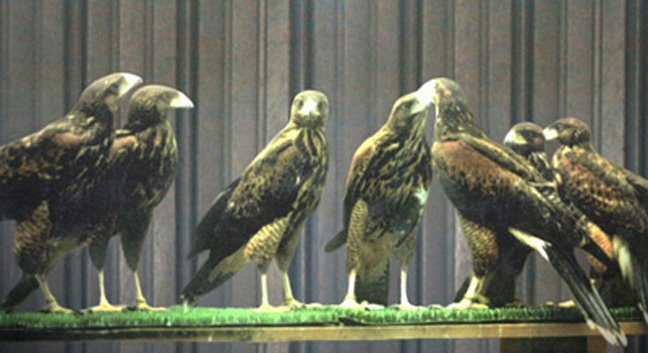
The hallway between the two mews not only provides security against an escaped bird but also provides storage for falconry equipment. Thinks are getting organized in that department.
THE ART OF FALCONRY




 The second mew has been framed in and will soon be complete. It will be modified to house Chapal the tiercel Peregrine.
The second mew has been framed in and will soon be complete. It will be modified to house Chapal the tiercel Peregrine.



 Well, the mew is nearly finished. Just a few finishing touches before added the Redtail hawklets.
Well, the mew is nearly finished. Just a few finishing touches before added the Redtail hawklets.  perches are designed to duplicate limbs of trees found in the wild but also keep the hawks away from the walls and windows. This greatly reduces the risk of plumage damage, especially to the flight feathers while giving the hawk an opportunity to enjoy the sun while viewing the countryside.
perches are designed to duplicate limbs of trees found in the wild but also keep the hawks away from the walls and windows. This greatly reduces the risk of plumage damage, especially to the flight feathers while giving the hawk an opportunity to enjoy the sun while viewing the countryside.




 Well, sometimes life literally thrusts opportunities or birds in your face and you have to choose what's best for both. Scirroco has a new best friend as of yesterday.
Well, sometimes life literally thrusts opportunities or birds in your face and you have to choose what's best for both. Scirroco has a new best friend as of yesterday. Raptors have some specific needs to be considered when constructing housing (a mew) and most governing agencies have guidelines or regulations for minimal requirments. Like all construction, starting with a level surface is key to easier and more stable construction. I have prefabricated and stained all the dimentional lumber as well as the wall OSB. The roof will be corrigated steel with a pitch of 1' in 4' to allow for easy snow removal. There will be a center hallway between two mews to provide for a double door safety system and storage of some falconry management equipment.
Raptors have some specific needs to be considered when constructing housing (a mew) and most governing agencies have guidelines or regulations for minimal requirments. Like all construction, starting with a level surface is key to easier and more stable construction. I have prefabricated and stained all the dimentional lumber as well as the wall OSB. The roof will be corrigated steel with a pitch of 1' in 4' to allow for easy snow removal. There will be a center hallway between two mews to provide for a double door safety system and storage of some falconry management equipment.
 After a week in my care Scirroco's contour and flight feathers are coming in as should be expected. The primaries and secondaries are approximately 2" long and the rectrices are showing about 1" of development accompanied with a thick cream tip band.
After a week in my care Scirroco's contour and flight feathers are coming in as should be expected. The primaries and secondaries are approximately 2" long and the rectrices are showing about 1" of development accompanied with a thick cream tip band.






